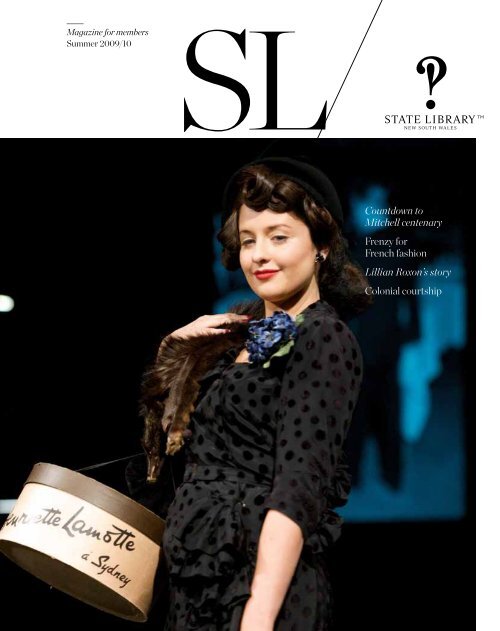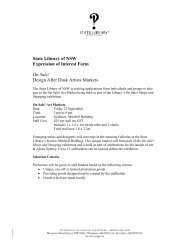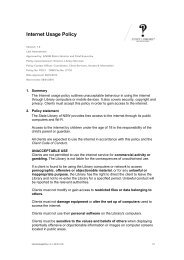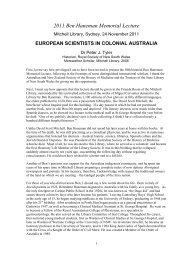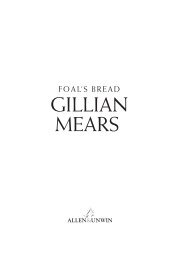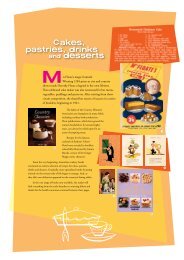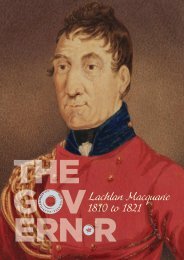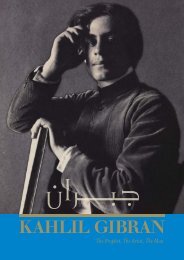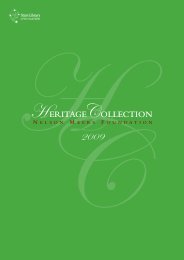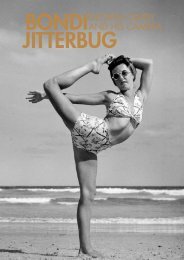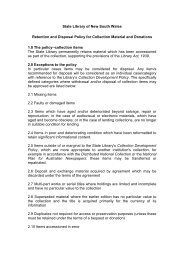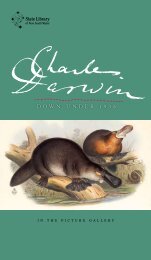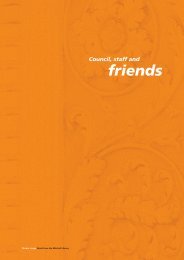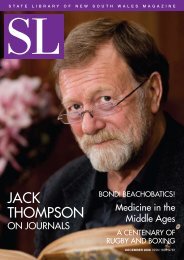Countdown to Mitchell centenary - State Library of New South Wales
Countdown to Mitchell centenary - State Library of New South Wales
Countdown to Mitchell centenary - State Library of New South Wales
You also want an ePaper? Increase the reach of your titles
YUMPU automatically turns print PDFs into web optimized ePapers that Google loves.
–Magazine for members<br />
Summer 2009/10<br />
SL<br />
<strong>Countdown</strong> <strong>to</strong><br />
<strong>Mitchell</strong> <strong>centenary</strong><br />
Frenzy for<br />
French fashion<br />
Lillian Roxon’s s<strong>to</strong>ry<br />
Colonial courtship<br />
s l m a g a z i n e Summer 2009/10 / <strong>State</strong> <strong>Library</strong> <strong>of</strong> <strong>New</strong> <strong>South</strong> <strong>Wales</strong> / i
‘‘<br />
Message Regina Sut<strong>to</strong>n<br />
It’s hard not <strong>to</strong> feel the buzz around the <strong>Library</strong> lately (and I’m<br />
not just referring <strong>to</strong> the construction work)! The energy in the<br />
air heralds big things ahead. A major new exhibition, a dynamic<br />
website, inspiring events — so much is planned for the <strong>centenary</strong><br />
<strong>of</strong> the <strong>Mitchell</strong> <strong>Library</strong> in 2010.<br />
Read about some <strong>of</strong> the highlights in this issue <strong>of</strong> SL.<br />
Plus, there’s French fashion, colonial exploration and the<br />
<strong>New</strong> York rock scene — unexpected s<strong>to</strong>ries from our vaults.<br />
You may have noticed the magazine’s new look. We begin our<br />
next 100 years with an updated image and logo for the <strong>Library</strong>.<br />
Our new logo is based on the ‘interrobang’, a curious<br />
punctuation mark used <strong>to</strong> show questioning and surprise:<br />
a question asked () and an answer given (!). The symbol is so apt<br />
for the <strong>Library</strong> — a place where answers are found in books,<br />
original documents, online resources and from our staff.<br />
We’re continuing at an extraordinary pace <strong>to</strong> improve access<br />
<strong>to</strong> our collections. Take a look at the <strong>Library</strong>’s 2009 Annual<br />
Report, on our website soon, <strong>to</strong> see the huge amount we’ve<br />
achieved in the past year. We’ve created 30,000 digital images<br />
from manuscripts and artworks, and 182,500 electronic<br />
catalogue records.<br />
You’ll see more and more rare material brought online, with<br />
an enhanced digitisation strategy led by our new Digitisation<br />
and Imaging Manager, Rory McLeod, who joins us from the<br />
British <strong>Library</strong>. Already Rory and his team are looking for<br />
exciting ways <strong>to</strong> increase access <strong>to</strong> the most in-demand items,<br />
as well as safe ways <strong>to</strong> preserve digital content over time.<br />
Whether you visit us online or at Macquarie Street, you’ll<br />
experience our collections in surprising ways. See the stunning<br />
<strong>centenary</strong> alphabet on display near the <strong>State</strong> Reference <strong>Library</strong>,<br />
and revealed letter-by-letter on the dedicated 2010 website.<br />
And find out why the <strong>Library</strong> has handmade bird whistles,<br />
a cow horn and Dame Nellie Melba’s Cartier hairpin case,<br />
when you visit the Stranger than Fiction display.<br />
As part <strong>of</strong> renewing our relationship with Foundation<br />
supporters, we’ll be providing better value <strong>to</strong> members.<br />
SL magazine is now available exclusively <strong>to</strong> Friends, Members<br />
and Volunteers. A range <strong>of</strong> added benefits will be delivered<br />
next year.<br />
We look forward <strong>to</strong> celebrating our <strong>centenary</strong> in 2010<br />
with you!<br />
Regina sut<strong>to</strong>n<br />
NSW <strong>State</strong> Librarian & Chief Executive<br />
‘
ontents<br />
‘<br />
cSummer 2009/10<br />
SL<br />
The magazine for<br />
foundaTion members,<br />
friends and VolunTeers<br />
is published quarTerly<br />
by The library CounCil<br />
<strong>of</strong> nsW.<br />
edi<strong>to</strong>R<br />
CaThy perkins<br />
Cperkins@sl.nsW.goV.au<br />
design & PRoduction<br />
dominiC hon<br />
Pho<strong>to</strong>gRaPhy<br />
unless oTherWise sTaTed,<br />
all phoTographiC/<br />
imaging Work is by<br />
sCoTT Wajon and bruCe<br />
york, imaging serViCes,<br />
sTaTe library <strong>of</strong> nsW.<br />
concePt & tyPogRaPhic<br />
diRection<br />
frosT design<br />
PRinting<br />
pegasus prinT group<br />
PaPeR<br />
raleigh paper<br />
eCosTar 200 gsm (CoVer)<br />
and 120 gsm (TexT) is<br />
made Carbon neuTral<br />
and The fibre sourCe has<br />
been independenTly<br />
CerTified by The foresT<br />
sTeWardship CounCil<br />
(fsC). eCosTar is<br />
manufaCTured from 100%<br />
posT Consumer reCyCled<br />
paper in a proCess<br />
Chlorine free<br />
enVironmenT under The<br />
iso 14001 enVironmenTal<br />
managemenT sysTem.<br />
summer 2009/10<br />
Vol. 2 no. 3<br />
issn 1835-9787<br />
p&d-3111-12/2009<br />
prinT run 3000<br />
state libRaRy <strong>of</strong> nsW<br />
maCquarie sTreeT<br />
sydney nsW 2000<br />
phone 02 9273 1414<br />
fax 02 9273 1255<br />
email<br />
library@sl.nsW.goV.au<br />
WWW.sl.nsW.goV.au<br />
oPening houRs<br />
monday To Thursday<br />
9 am To 8 pm<br />
friday 9 am To 5 pm<br />
Weekends 10 am To 5 pm<br />
The miTChell library<br />
reading room is Closed<br />
on sundays.<br />
fRont coveR<br />
from The library’s<br />
preT-a-porTer fashion<br />
parade. afTernoon<br />
dress by emmeline<br />
manassé, rue sT honore,<br />
paris, C. 1948, darnell<br />
ColleCTion, sydney,<br />
model anneTTe TWemloW,<br />
phoTo by louise Whelan<br />
back coveR<br />
bird WhisTles, 1960s,<br />
henry graCe, Tin and<br />
brass, r408–17<br />
oPPosite<br />
phoTo by dieu Tan<br />
2 celebRating<br />
ONE hundred years <strong>of</strong><br />
the <strong>Mitchell</strong> <strong>Library</strong><br />
6 neWs<br />
Open for business<br />
eRecords for<br />
remarkable bibles<br />
First Fleet journals<br />
recognised by<br />
UNESCO<br />
Future <strong>of</strong> libraries<br />
<strong>New</strong> research<br />
partnership: His<strong>to</strong>ry<br />
<strong>of</strong> climate change<br />
8 on this day …<br />
10 featuRe<br />
Frenzy for<br />
French fashion<br />
16 featuRe<br />
In<strong>to</strong> the interior<br />
20 featuRe<br />
Mother <strong>of</strong> rock:<br />
Lillian Roxon’s s<strong>to</strong>ry<br />
24 neW acquisitions<br />
A second exposure<br />
Above the traffic<br />
26 a living collection<br />
Colonial courtship<br />
28 building a stRong<br />
foundation<br />
30 foR ouR fRiends<br />
3 1 Recent highlights<br />
32 the libRaRy shoP<br />
<strong>New</strong> books and<br />
merchandise<br />
33 q&a<br />
Raimond Gaita<br />
s l m a g a z i n e Summer 2009/10 / <strong>State</strong> <strong>Library</strong> <strong>of</strong> <strong>New</strong> <strong>South</strong> <strong>Wales</strong> / 1
To overrate the<br />
<strong>of</strong> the lib<br />
aid <strong>to</strong> the<br />
his <strong>of</strong><br />
would<br />
2 / s l m a g a z i n e Summer 2009/10 / <strong>State</strong> <strong>Library</strong> <strong>of</strong> <strong>New</strong> <strong>South</strong> <strong>Wales</strong>
value<br />
rary as an<br />
study<br />
<strong>to</strong>ry<br />
<strong>of</strong> the<br />
Australia<br />
Celebrating 100 years<br />
<strong>of</strong> the MitChell library<br />
in 2010<br />
be impossible …<br />
lord Chelmsford, goVernor <strong>of</strong> nsW,<br />
miTChell library opening, 8 marCh 1910<br />
s l m a g a z i n e Summer 2009/10 / <strong>State</strong> <strong>Library</strong> <strong>of</strong> <strong>New</strong> <strong>South</strong> <strong>Wales</strong> / 3
Celebrating<br />
ONE hundred years<br />
<strong>of</strong> the <strong>Mitchell</strong> <strong>Library</strong>
In 2010 we’re celebrating the <strong>centenary</strong> <strong>of</strong> the <br />
<strong>Mitchell</strong> <strong>Library</strong>. On 9 March for 100 days a <br />
major exhibition will display 100 <strong>of</strong> our most <br />
intriguing items. ONE hundred is a rollcall <strong>of</strong> the <br />
famous and the no<strong>to</strong>rious from Australia’s past, <br />
the quiet achievers and the noisy larrikins, <br />
the conventional and the rebellious, <br />
the remembered and the forgotten — <br />
all have a fascinating s<strong>to</strong>ry <strong>to</strong> tell. <br />
Bringing the<br />
collection OUT<br />
Throughout 2010 we’re bringing the<br />
<strong>Mitchell</strong> collection out <strong>of</strong> the vaults.<br />
The <strong>Mitchell</strong> <strong>Library</strong> began with the<br />
personal collection <strong>of</strong> David Scott<br />
<strong>Mitchell</strong>, who bequeathed over 40,000<br />
works and a large endowment <strong>to</strong> the<br />
people <strong>of</strong> NSW. The <strong>Library</strong> has been<br />
adding <strong>to</strong> it ever since. In our <strong>centenary</strong><br />
year there are lots <strong>of</strong> surprises in s<strong>to</strong>re,<br />
with behind-the-scenes <strong>to</strong>urs, regional<br />
Our new<br />
alphabet <strong>Countdown</strong><br />
displays and a virtual time capsule. We’ve created an alphabet Follow the countdown <strong>to</strong> the<br />
that brings out the broad and ONE hundred exhibition <br />
eclectic collections <strong>of</strong> the opening on our <strong>centenary</strong> <br />
<strong>State</strong> <strong>Library</strong> in an unexpected micro-site. Check out the <br />
way. With the original concept release <strong>of</strong> our alphabet — <br />
by Frost Design, each letter is a couple <strong>of</strong> letters per week — <br />
made up <strong>of</strong> elements from and the full program <strong>of</strong> events <br />
maps, manuscripts, ephemera, and activities celebrating the <br />
relics and even <strong>Library</strong><br />
<strong>Mitchell</strong> <strong>Library</strong> <strong>centenary</strong>.<br />
architecture. The alphabet, www.onehundred.sl.nsw.gov.au<br />
and the many s<strong>to</strong>ries it tells, <br />
will extend well beyond the <br />
<strong>Mitchell</strong> <strong>centenary</strong> year. <br />
s l m a g a z i n e Summer 2009/10 / <strong>State</strong> <strong>Library</strong> <strong>of</strong> <strong>New</strong> <strong>South</strong> <strong>Wales</strong> / 5
Open for <br />
business<br />
In preparation for our<br />
<strong>centenary</strong> celebrations in<br />
2010, we’re undertaking<br />
essential building work.<br />
The <strong>Mitchell</strong> <strong>Library</strong> reading<br />
room remains open, but the<br />
external doors will be closed<br />
during this time. Please enter<br />
through the Macquarie Street<br />
wing. The improvements will<br />
leave us with a refurbished<br />
gallery space, more visi<strong>to</strong>rfriendly<br />
public areas and a<br />
new air-conditioning system.<br />
The Galleries will reopen<br />
on 9 March 2010 for the<br />
ONE hundred exhibition.<br />
eRecords for remarkable Bibles<br />
You can now search online for thousands <strong>of</strong> titles in the <strong>State</strong> <strong>Library</strong><br />
collections that could previously be found only through the card<br />
catalogue. A collection <strong>of</strong> rare Bibles is among the 180,000 items that<br />
have new eRecords.<br />
The Bible that gave us such popular phrases as ‘<strong>to</strong> pour out one’s heart’,<br />
‘pride goes before a fall’ and ‘<strong>to</strong> fall flat on his face’ — the King James or<br />
Authorised Version <strong>of</strong> 1611 — is represented in several editions. There are<br />
oversized and miniature Bibles, including a tiny <strong>New</strong> Testament from 1598<br />
that’s one <strong>of</strong> the earliest examples <strong>of</strong> miniature book production.<br />
The family who donated the Bibles <strong>to</strong> the <strong>Library</strong> in 1926, the<br />
Richardsons, believed they were related <strong>to</strong> bible publisher and martyr John<br />
Rogers. Rogers was burnt at the stake in 1555 for printing a Bible in English.<br />
The fascinating his<strong>to</strong>ry <strong>of</strong> Bible publishing in England reflects social,<br />
political and religious upheavals from the 16th century <strong>to</strong> <strong>to</strong>day.<br />
image: seleCTion from The riChardson bible ColleCTion<br />
6 / s l m a g a z i n e Summer 2009/10 / <strong>State</strong> <strong>Library</strong> <strong>of</strong> <strong>New</strong> <strong>South</strong> <strong>Wales</strong>
n e w s<br />
First Fleet<br />
journals<br />
recognised<br />
by UNESCO<br />
Our unrivalled collection<br />
<strong>of</strong> First Fleet journals was<br />
recently added <strong>to</strong> the<br />
UNESCO Australia Memory<br />
<strong>of</strong> the World Register. The<br />
<strong>Library</strong> holds nine <strong>of</strong> the<br />
11 First Fleet journals known<br />
<strong>to</strong> exist, providing first-hand<br />
accounts <strong>of</strong> the voyage <strong>to</strong><br />
Australia and early settlement<br />
from 1787 <strong>to</strong> the 1790s.<br />
The Memory <strong>of</strong> the World<br />
program aims <strong>to</strong> safeguard<br />
and raise awareness <strong>of</strong> the<br />
documentary heritage <strong>of</strong><br />
humanity. The First Fleet<br />
journals are available <strong>to</strong> read<br />
on our website.<br />
image: boTany bay (deTail), 1788,<br />
Charles gore, WaTerColour, dg V1a/8<br />
Future <strong>of</strong><br />
libraries<br />
How will the global financial<br />
crisis, climate change and an<br />
ageing population change and<br />
shape NSW public libraries in<br />
the future What will be the<br />
effect <strong>of</strong> technologies such as<br />
e-books and web 2.0 Research<br />
by the <strong>State</strong> <strong>Library</strong> and NSW<br />
public libraries has looked at<br />
future scenarios that could<br />
affect public libraries over the<br />
next 20 years, and ways we can<br />
respond <strong>to</strong> change. A report,<br />
The Bookends Scenarios:<br />
Alternative Futures for the<br />
Public <strong>Library</strong> Network in<br />
NSW in 2030, was recently<br />
prepared by Neville Freeman<br />
Agency and will be<br />
available on our website.<br />
<strong>New</strong> research<br />
partnership:<br />
His<strong>to</strong>ry <strong>of</strong> <br />
climate change<br />
A research team from the University <strong>of</strong> Melbourne<br />
has partnered with the <strong>State</strong> <strong>Library</strong> <strong>of</strong> NSW and<br />
other key libraries <strong>to</strong> develop a climate his<strong>to</strong>ry for<br />
south-eastern Australia. Surprisingly, climate<br />
records such as temperature and rainfall<br />
measurements have only been kept <strong>of</strong>ficially in<br />
Australia for about 100 years. If it hadn’t been for<br />
early European explorers and settlers, we would have<br />
few accounts <strong>of</strong> weather patterns pre-dating the<br />
1900s. The landmark project, led by Dr Joelle Gergis<br />
and Pr<strong>of</strong>essor David Karoly, will comb the <strong>Library</strong>’s<br />
archives <strong>to</strong> capture Australia’s climatic past and<br />
help determine the extent <strong>of</strong> human-caused<br />
climate change.<br />
image: fenCing aT breWarrina (deTail), 2002, darren Clark, pxa 1069<br />
s l m a g a z i n e Summer 2009/10 / <strong>State</strong> <strong>Library</strong> <strong>of</strong> <strong>New</strong> <strong>South</strong> <strong>Wales</strong> / 7
22 December 1888<br />
The Bulletin publishes the first <br />
short s<strong>to</strong>ry by Henry Lawson, <br />
aged 21, entitled ‘His Father’s <br />
Mate’.<br />
image: pen WiTh sTand <br />
oWned by henry laWson <br />
C. 1900, r 64<br />
1 January 1810<br />
Lachlan Macquarie becomes<br />
Governor <strong>of</strong> NSW. In his own<br />
words, Macquarie ‘found the<br />
colony barely emerging from<br />
infantile imbecility’ and left it<br />
‘enjoying a state <strong>of</strong> private<br />
comfort and public<br />
prosperity’.<br />
image: laChlan maCquarie, C. 1819<br />
WaTerColour on iVory miniaTure<br />
min 236<br />
24 December 1789<br />
The convict ship Guardian<br />
strikes ice en route <strong>to</strong> save<br />
the starving colony <strong>of</strong> NSW.<br />
The dramatic wreck made<br />
international headlines and<br />
resulted in conditional<br />
pardons for 14 <strong>of</strong> the surviving<br />
convicts.<br />
17 January 1877<br />
May Gibbs, children’s book<br />
illustra<strong>to</strong>r and crea<strong>to</strong>r <strong>of</strong><br />
Snuggle Pot and Cuddle Pie,<br />
is born at Cowell, <strong>South</strong><br />
Australia.<br />
CapTion: ‘danCing’, 1918<br />
illusTraTion by may gibbs for<br />
Snuggle Pot and Cuddle Pie<br />
pxd 304/V.2/153<br />
image: the PerilouS Situation <strong>of</strong> ‘the<br />
guardian’ frigate … possibly by roberT<br />
dighTon, C. 1790, pen, ink and<br />
WaTerColour, ml 1112 (b)<br />
8 / s l m a g a z i n e Summer 2009/10 / <strong>State</strong> <strong>Library</strong> <strong>of</strong> <strong>New</strong> <strong>South</strong> <strong>Wales</strong>
day<br />
on this<br />
2 February 1966<br />
Protests take place in Sydney during the<br />
intake <strong>of</strong> conscripts for the Vietnam War.<br />
image: VieTnam War proTesTer<br />
1966, on 173<br />
23 February 1931<br />
Internationally renowned<br />
opera singer Dame Nellie<br />
Melba dies in Sydney. Melba<br />
was made a Dame Commander<br />
<strong>of</strong> the British Empire in 1918<br />
for services <strong>to</strong> World War I.<br />
image: nellie melba (deTail)<br />
1903, phoTo by Talma & Co<br />
p1/melba, nellie (bm)<br />
coRRection<br />
In ‘On this day’<br />
SL August 2009<br />
(p. 21), a picture <strong>of</strong><br />
Governor Phillip’s<br />
farm was<br />
incorrectly<br />
captioned as<br />
belonging <strong>to</strong><br />
James Ruse.<br />
s l m a g a z i n e Summer 2009/10 / <strong>State</strong> <strong>Library</strong> <strong>of</strong> <strong>New</strong> <strong>South</strong> <strong>Wales</strong> / 9
f e a t u r e<br />
f r e n z y<br />
for<br />
French Fashion<br />
W o R d s Margot Riley<br />
10 / s l m a g a z i n e Summer 2009/10 / <strong>State</strong> <strong>Library</strong> <strong>of</strong> <strong>New</strong> <strong>South</strong> <strong>Wales</strong>
In July 1948 Sydney audiences were<br />
treated <strong>to</strong> the first complete collection<br />
<strong>of</strong> Christian Dior’s revolutionary<br />
‘<strong>New</strong> Look’ fashions shown outside<br />
Paris. Through pho<strong>to</strong>graphs, personal<br />
papers and magazines, cura<strong>to</strong>r<br />
Margot Riley has uncovered surprising<br />
insights in<strong>to</strong> the events that led <strong>to</strong><br />
this defining moment. It’s the s<strong>to</strong>ry<br />
behind this year’s sell-out Pret-aporter<br />
Fashion Parade, presented<br />
by the <strong>Library</strong> at the S<strong>of</strong>itel Sydney<br />
Wentworth.<br />
lefT: madame<br />
ChambrelenT models The<br />
signaTure ‘bar’ suiT from<br />
ChrisTian dior’s firsT<br />
‘neW look’ ColleCTion,<br />
auStralian Women’S<br />
Weekly, 9 augusT 1947<br />
beloW: ‘sTyle symposium<br />
from paris’, auStralian<br />
Women’S Weekly,<br />
21 sepTember 1946<br />
opposiTe: baCk sTage,<br />
deparTmenT sTore<br />
fashion parade, mark<br />
foy’s, sydney, marCh 1947,<br />
Pix arChiVe, aCp<br />
From wine and wool <strong>to</strong> food and fashion, the French<br />
have always had a thing or two <strong>to</strong> teach Australians<br />
about the art <strong>of</strong> combining business and pleasure.<br />
Having supplied the French fashion industry with<br />
wool for nearly a century, Australia became an eager<br />
participant in the global market for French style after<br />
World War II.<br />
Anxious <strong>to</strong> cut out the British middle men, French<br />
textile companies had been buying wool directly<br />
from Australia since the 1850s. When the wool trade<br />
<strong>to</strong>ok <strong>of</strong>f during the second half <strong>of</strong> the century, France<br />
became Australia’s largest cus<strong>to</strong>mer after Britain.<br />
By 1900, Australia was leading the world in the<br />
production <strong>of</strong> fine merino wool and many French<br />
wool-buying firms had representatives stationed<br />
here permanently.<br />
It is hard <strong>to</strong> overestimate the influence <strong>of</strong> the<br />
wool-buyers and their coterie on Australian attitudes<br />
<strong>to</strong> French culture at this time. Bringing with them a<br />
taste for Parisian luxuries and the sophistication <strong>of</strong><br />
European city life, the elegant subset <strong>of</strong> Sydney<br />
society (known as le <strong>to</strong>ut-Sydney) ensured that a<br />
French fixation thrived.<br />
This was an era in which an elegant woman<br />
might change outfits four times a day — for travelling,<br />
lunching and visiting, going <strong>to</strong> the races, cocktails,<br />
dinner and balls. But only the very wealthy could<br />
s l m a g a z i n e Summer 2009/10 / <strong>State</strong> <strong>Library</strong> <strong>of</strong> <strong>New</strong> <strong>South</strong> <strong>Wales</strong> / 11
f r e n z y f o r f r e n C h f a s h i o n<br />
experience first-hand the rarefied ambience <strong>of</strong><br />
Parisian haute couture (high fashion) houses. For the<br />
small number <strong>of</strong> Australians who travelled regularly<br />
and could afford it, haute couture could be purchased<br />
directly from these exclusive establishments,<br />
provided one had the right introductions, and the<br />
time <strong>to</strong> undertake several fittings and wait a month<br />
for the garments <strong>to</strong> be completed.<br />
Back home, several couture salons had opened in<br />
Sydney during the interwar period. Bearing French<br />
names, and cashing in on the prestige <strong>of</strong> Paris fashion<br />
and all things French, these businesses modelled<br />
their operations on French workrooms. Local<br />
couturiers like Madam Rochas, Paulette Pellier,<br />
Germaine Rocher, and milliner Henriette Lamotte,<br />
numbered among their clientele the wives and<br />
daughters <strong>of</strong> successful business men, female<br />
members <strong>of</strong> important Australian families and<br />
leading Sydney socialites.<br />
Australian women could also buy French fashion<br />
through the better department s<strong>to</strong>res such as<br />
Sydney’s Mark Foys and David Jones. The latter<br />
was particularly noted for its French salon,<br />
where shoppers could select from an array <strong>of</strong><br />
ready-made gowns.<br />
By the end <strong>of</strong> World War II, people were ready <strong>to</strong><br />
indulge themselves after years <strong>of</strong> wartime austerity.<br />
The troops came home <strong>to</strong> their families and women<br />
longed for romance and feminine clothes, but little<br />
was happening in the Australian garment industry.<br />
Due <strong>to</strong> a lack <strong>of</strong> materials and labour, there was a<br />
shortage <strong>of</strong> apparel in the s<strong>to</strong>res. In an attempt <strong>to</strong><br />
stimulate the local rag trade and revitalise<br />
production, several leading businessmen teamed up<br />
<strong>to</strong> bring an exhibition <strong>of</strong> French haute couture<br />
fashion <strong>to</strong> Australia.<br />
Department s<strong>to</strong>re owners Norman Myer (Myer,<br />
Melbourne and Adelaide) and Charles Lloyd Jones<br />
(David Jones, Sydney) were keen <strong>to</strong> whet the fashionstarved<br />
appetites <strong>of</strong> their cus<strong>to</strong>mers and encourage<br />
consumer spending. Frank Packer, owner <strong>of</strong> the<br />
Australian Women’s Weekly, was anxious <strong>to</strong> woo<br />
the David Jones advertising account over <strong>to</strong> his<br />
publications.<br />
In early 1946, Mary Hordern, fashion edi<strong>to</strong>r<br />
<strong>of</strong> the Weekly and Packer’s sister-in-law, was sent<br />
<strong>to</strong> Paris <strong>to</strong> choose the collection <strong>of</strong> French fashions<br />
<strong>to</strong> be paraded around the country. A powerful local<br />
authority on fashion, Hordern was an attractive<br />
woman with a statuesque figure well-suited <strong>to</strong><br />
wearing the clothes she wrote about. It was her<br />
idea <strong>to</strong> recruit four Parisian mannequins <strong>to</strong> show<br />
Australian audiences how these clothes should<br />
be worn.<br />
Hordern inspected some 5000 garments over a<br />
three-month period, selecting 120 ensembles that<br />
represented the essence <strong>of</strong> French fashion yet were<br />
suited <strong>to</strong> Australian life. Each outfit was fully<br />
accessorised, and ranged from simple clothes for<br />
specta<strong>to</strong>r sports and the beach <strong>to</strong> evening gowns.<br />
lefT: ‘The ausTralian<br />
Women’s Weekly paris<br />
fashion parade’, CoVer,<br />
auStralian Women’S<br />
Weekly, 21 sepTember 1946<br />
opposiTe: frenCh fashion<br />
parade, prinCe’s<br />
resTauranT, sydney, 1956,<br />
phoTograph by<br />
jaCk hiCkson, apa 01445<br />
12 / s l m a g a z i n e Summer 2009/10 / <strong>State</strong> <strong>Library</strong> <strong>of</strong> <strong>New</strong> <strong>South</strong> <strong>Wales</strong>
Successive issues <strong>of</strong> the Weekly reported every aspect<br />
<strong>of</strong> Horden’s experience in Paris, declaring that<br />
‘Fabrics — even prewar fabrics — have never been<br />
lovelier’. All the ‘woolens were woven from<br />
Australian wool’, and readers were reminded that the<br />
French appreciated the quality <strong>of</strong> our fine fleece over<br />
the embellishments added by their designers.<br />
Under the supervision <strong>of</strong> Caroline Chambrelent,<br />
Directress <strong>of</strong> the House <strong>of</strong> Worth, the French<br />
mannequins made the gruelling six-day flight from<br />
Paris by flying boat. Arriving in August <strong>to</strong> begin<br />
their <strong>to</strong>ur, the women quickly became the <strong>to</strong>ast<br />
<strong>of</strong> the <strong>to</strong>wn.<br />
Staged with all the glamour <strong>of</strong> a Rue de la Paix<br />
salon, the French fashion parades opened in the<br />
Grand Ballroom <strong>of</strong> David Jones’ Elizabeth Street<br />
s<strong>to</strong>re on 16 September 1946. Sydney women flocked<br />
<strong>to</strong> the twice-daily showings just as eager <strong>to</strong> catch a<br />
glimpse <strong>of</strong> the stunning mannequins as the garments<br />
themselves, which few could have afforded and were<br />
not for sale anyway.<br />
The <strong>to</strong>ur continued on <strong>to</strong> Myer in Melbourne<br />
and Adelaide, and Finney Isles in Brisbane. The<br />
parades became famous, boosting the Weekly’s sales<br />
(circulation 700,000 in 1946) and encouraging the<br />
magazine <strong>to</strong> stage three more French fashion<br />
extravaganzas in 1947, 1948 and 1949.<br />
While the parades brought thousands <strong>of</strong> cus<strong>to</strong>mers<br />
in<strong>to</strong> the department s<strong>to</strong>res, Mary Hordern’s failure <strong>to</strong><br />
secure local manufacturing licences was perceived,<br />
by David Jones in particular, as a lost merchandising<br />
opportunity.<br />
In 1947 David Jones launched its ‘Paris Fashion for<br />
All’ policy, with the intention <strong>of</strong> securing licences <strong>to</strong><br />
reproduce Australian adaptations <strong>of</strong> French model<br />
garments in their Surry Hills workrooms.<br />
It was also the year Christian Dior launched his<br />
first collection in Paris. Dubbed the ‘<strong>New</strong> Look’, it put<br />
French fashion on the front page <strong>of</strong> newspapers all<br />
over the world, rendering existing styles démodé<br />
overnight. To a wartime generation, Dior’s fashions<br />
embodied the rediscovery <strong>of</strong> happiness, with his<br />
extravagant use <strong>of</strong> fabric, sweeping skirts and nippedin<br />
waists perfectly timed <strong>to</strong> satisfy a world starved<br />
<strong>of</strong> luxury, beauty and glamour. Soon after the ‘<strong>New</strong><br />
Look’ debuted in February, David Jones secured a<br />
franchise with the House <strong>of</strong> Dior.<br />
s l m a g a z i n e Summer 2009/10 / <strong>State</strong> <strong>Library</strong> <strong>of</strong> <strong>New</strong> <strong>South</strong> <strong>Wales</strong> / 13
f r e n z y f o r f r e n C h f a s h i o n<br />
At the 1947 Spring Paris openings, Australia was<br />
the biggest buyer, with David Jones becoming the<br />
first Australian retailer <strong>to</strong> purchase a complete haute<br />
couture collection. Sixty model garments, by various<br />
designers, were airmailed out <strong>to</strong> Sydney with a<br />
complete range <strong>of</strong> accessories so David Jones’<br />
cus<strong>to</strong>mers would see the <strong>to</strong>ut ensemble as paraded<br />
in Paris.<br />
For the gala opening, on 18 July, 800 people packed<br />
the Bois de Rose salon, specially created on the fourth<br />
floor <strong>of</strong> David Jones’ Elizabeth Street s<strong>to</strong>re, where<br />
the French garments were shown, side-by-side, with<br />
their Australian adaptations.<br />
The benefit <strong>of</strong> David Jones’ ‘Paris Fashion for All’<br />
parades was threefold: for the first time the average<br />
Australian consumer had access <strong>to</strong> current season<br />
French fashion and French designs adapted <strong>to</strong> the<br />
Australian climate and lifestyle; Australian<br />
mannequins gained valuable career experience in<br />
parading high fashion garments; and Australian<br />
workers were trained in Parisian haute couture<br />
methods <strong>of</strong> cutting, construction and finishing.<br />
In the space <strong>of</strong> a year, Christian Dior<br />
re-established Paris as the heart <strong>of</strong> fashion<br />
innovation, and his follow-up collection for spring<br />
1948 was the most anticipated and watched spectacle<br />
<strong>of</strong> the fashion world.<br />
On the local scene, David Jones staged a further<br />
coup over its rivals by securing ‘the first Dior-only<br />
collection <strong>to</strong> be shown outside Paris’, for its spring<br />
1948 parades. ‘<strong>New</strong> Look’ garments from this his<strong>to</strong>ric<br />
collection would be shown in Australia before being<br />
seen anywhere else in the world, with local<br />
adaptations available for sale.<br />
Dior collaborated with David Jones because he<br />
knew that very few Australians had the chance <strong>to</strong><br />
visit Paris. He acknowledged Australia’s enthusiasm<br />
for his extravagant designs, which had attracted<br />
criticism in Europe. Perhaps local audiences saw his<br />
generous use <strong>of</strong> materials as a much-needed stimulus<br />
<strong>to</strong> Australian wool and cot<strong>to</strong>n producers. ‘Living in<br />
the sunshine <strong>of</strong> a comparatively new country,<br />
unscathed by war,’ Dior <strong>to</strong>ld the Sydney Morning<br />
Herald, ‘the Australians have a cleaner brighter<br />
outlook and are more receptive <strong>to</strong> new ideas than the<br />
tired people <strong>of</strong> Europe.’<br />
The couturier despatched 10 packing crates <strong>to</strong><br />
Australia containing the original model garments<br />
selected by David Jones’ fashion buyer Alice Condon,<br />
along with Dior-designed hats and accessories.<br />
Arriving on 25 June 1948, the garments from his<br />
Envol (flight) and Zig Zag lines were carefully<br />
unpacked and minutely examined in the David Jones’<br />
workrooms. A range <strong>of</strong> adaptations was then<br />
designed and manufactured, faithfully reproducing<br />
the superb workmanship <strong>of</strong> Paris haute couture.<br />
On opening night in late July, the social set was far<br />
outnumbered by members <strong>of</strong> the Sydney fashion<br />
trade, armed with paper and pencils <strong>to</strong> sketch the<br />
styles and coiffures. Alongside the 50 Dior originals<br />
and 34 Australian adaptations, David Jones’ 1948<br />
spring/summer collection included designs from the<br />
houses <strong>of</strong> Paquin, Carven, Gres, Lelong, Piguet and<br />
Jacques Fath, as well as 25 garments specially<br />
designed by Pierre Balmain for the Australian<br />
market. The ensembles were paraded by<br />
12 Australian mannequins matched <strong>to</strong> the exact<br />
measurements and colouring <strong>of</strong> Dior’s house models<br />
for whom the original gowns had been created.<br />
The tiny 19-inch waist <strong>of</strong> model Narelle Findlay,<br />
in particular, caused quite a stir.<br />
As well as capturing the imagination <strong>of</strong> the<br />
Australian buying public, the frenzy for French<br />
fashion stimulated local designers and<br />
manufacturers <strong>to</strong> such an extent that 1950 saw the<br />
inauguration <strong>of</strong> the Australian Fashion Fair. Madame<br />
Chambrelent (now Mrs Kenneth Cole and a resident)<br />
was given the task <strong>of</strong> organising this first Australianonly<br />
fashion exhibition, concluding in the Weekly:<br />
‘In the 4 years since I first visited Australia<br />
I have been greatly impressed with the rapid<br />
development <strong>of</strong> the fashions [by local designers] and<br />
feel sure that Australia should soon become one <strong>of</strong><br />
the world’s youngest fashion leaders.’<br />
opposiTe: This runWay<br />
look from The library’s<br />
preT-a-porTer fashion<br />
parade pays TribuTe To<br />
madame ChambrelenT,<br />
Who Wore a royal blue<br />
Wool suiT on arriVal in<br />
sydney in 1946, darnell<br />
ColleCTion, sydney,<br />
model Clare Wegryzn<br />
14 / s l m a g a z i n e Summer 2009/10 / <strong>State</strong> <strong>Library</strong> <strong>of</strong> <strong>New</strong> <strong>South</strong> <strong>Wales</strong>
f e a t u r e<br />
i n t o<br />
t h e <br />
i n t e r i o r<br />
W o R d s Olwen Pryke<br />
*<br />
t h e l i b r a r y h a s d i g i t i s e d t h e<br />
j o u r n a l o f y o u n g e x p l o r e r j o h n p r i C e ,<br />
w h i C h C h r o n i C l e s t w o l i t t l e - k n o w n<br />
a t t e m p t s t o s o l v e t h e m y s t e r i e s<br />
o f a f o r e i g n l a n d .<br />
aboVe: menura SuPerba,<br />
from an aCCount <strong>of</strong> the<br />
engliSh Colony in neW<br />
<strong>South</strong> WaleS, 1798–1802,<br />
daVid Collins, q79/61<br />
opposiTe: VieW on The<br />
Worrogoomboo riVer,<br />
nsW (deTail), C. 1822–23,<br />
joseph lyCeTT, dgd 1/10<br />
16 / s l m a g a z i n e Summer 2009/10 / <strong>State</strong> <strong>Library</strong> <strong>of</strong> <strong>New</strong> <strong>South</strong> <strong>Wales</strong>
i n t o t h e i n t e r i o r<br />
Not only did this strange antipodean place represent<br />
a complete unknown for the first European settlers,<br />
the interior added a further layer <strong>of</strong> mystery. The<br />
unmapped landscape served as a significant<br />
deterrent <strong>to</strong> would-be absconders — a natural prison<br />
wall for the penal colony — but it also represented the<br />
possibility <strong>of</strong> finding land and water <strong>to</strong> supply the<br />
precarious settlement. It elicited both fear and hope.<br />
The mysteries <strong>of</strong> the interior also prompted<br />
wonderful tales. For years, rumours <strong>of</strong> an Arcadia just<br />
beyond the mountains had circulated in the colony,<br />
capturing the imagination <strong>of</strong> those desperate for food<br />
and freedom.<br />
Daring individuals recognised a seductive means<br />
<strong>of</strong> escape. A group <strong>of</strong> Irish convicts <strong>to</strong>ok <strong>to</strong> the bush<br />
in November 1791, believing they could walk <strong>to</strong><br />
China. Twenty-one set out, but before the close <strong>of</strong> the<br />
month most had been found, naked and starving.<br />
Several had perished.<br />
Governor Hunter warned the convict population<br />
not <strong>to</strong> be misled by idle s<strong>to</strong>ries. He proposed an<br />
expedition <strong>to</strong> dispel the rumours and ‘prevent that<br />
loss <strong>of</strong> life which must certainly attend every attempt<br />
<strong>to</strong> discover this fancied paradise’.<br />
A party was formed and the date <strong>of</strong> departure set<br />
for January 1798. Accompanying four convicts and<br />
their guards were John Wilson and the young John<br />
Price, a servant <strong>to</strong> Governor Hunter who had arrived<br />
in the colony as a 16-year-old. Price enjoyed the bush<br />
and was eager <strong>to</strong> see more <strong>of</strong> the hinterland.<br />
Wilson’s reasons for accompanying the expedition<br />
were more complicated. A seafarer convicted <strong>of</strong><br />
stealing nine yards <strong>of</strong> cloth, he had arrived with the<br />
First Fleet in 1788. When his seven-year sentence<br />
expired — or even before that, according <strong>to</strong> some<br />
accounts — Wilson chose <strong>to</strong> live with the<br />
neighbouring Indigenous peoples. He was given the<br />
name Bun-bo-e, picked up some local dialect, and had<br />
become a skilled bushman.<br />
In May 1797, Governor Hunter issued a general<br />
order that named Wilson and other absconders. They<br />
were required <strong>to</strong> submit themselves <strong>to</strong> peace <strong>of</strong>fcers<br />
or be outlawed. Wilson made his way <strong>to</strong> Parramatta,<br />
arriving dressed only in a kangaroo hide apron, with<br />
his skin scarified. According <strong>to</strong> David Collins, the<br />
colony’s first judge-advocate, Wilson claimed <strong>to</strong> have<br />
journeyed ‘upward <strong>of</strong> 100 miles in every direction<br />
around the settlement’. His familiarity with the<br />
surroundings would prove invaluable for the<br />
expedition.<br />
The party set out the following January. Faced<br />
with the prospect <strong>of</strong> climbing through the rugged<br />
bushland near Pic<strong>to</strong>n, the convicts quickly grew tired.<br />
Most returned <strong>to</strong> Sydney, accompanied by their<br />
guards. Price, Wilson and another man, possibly one<br />
<strong>of</strong> the convicts named Roe, continued on. Wilson’s<br />
knowledge <strong>of</strong> the land allowed the party <strong>to</strong> head in a<br />
south-westerly direction, journeying through an area<br />
later known as the <strong>South</strong>ern Highlands.<br />
We know a great deal about the expedition because<br />
<strong>of</strong> an unusual circumstance: although he was the<br />
governor’s servant, John Price was literate. Because<br />
Price ‘grew up in that country and became pleased<br />
with travelling through the woods’, Governor Hunter<br />
later wrote <strong>to</strong> Sir Joseph Banks, ‘he solicited<br />
permission <strong>to</strong> go upon the excursion then intended,<br />
and as he could write, he was instructed <strong>to</strong> enter in a<br />
paper, the observations which their journey might<br />
suggest. He is an intelligent lad.’<br />
Price’s journal supplies the first written recording<br />
<strong>of</strong> the lyrebird and the koala, and the first mainland<br />
account <strong>of</strong> the wombat, all observed on 26 January<br />
1798, 10 years after the First Fleet arrived in<br />
Port Jackson. The party also shot a lyrebird,<br />
carrying it with them and presenting the specimen<br />
<strong>to</strong> Governor Hunter on their return.<br />
18 / s l m a g a z i n e Summer 2009/10 / <strong>State</strong> <strong>Library</strong> <strong>of</strong> <strong>New</strong> <strong>South</strong> <strong>Wales</strong>
Eventually the expedition reached the junction <strong>of</strong><br />
the Wingecarribee and Wollondilly rivers, far south<br />
<strong>of</strong> Parramatta. Turning home, hungry and exhausted,<br />
the men cut up their clothing and used the cloth <strong>to</strong><br />
protect their feet. Price was convinced that ‘we must<br />
all have perished with hunger, which certainly would<br />
have been the case had it not been for the<br />
indefatigable zeal <strong>of</strong> Wilson <strong>to</strong> supply us with as<br />
much as would support life’.<br />
A second expedition <strong>to</strong> the south-west was later<br />
conducted by Wilson, Price and a man named Collins<br />
in early March <strong>of</strong> the same year. This time the men<br />
reached Mount Towrang, near present day Goulburn.<br />
The two expeditions revealed the rich tablelands that<br />
later provided valuable grazing for sheep and cattle.<br />
Some his<strong>to</strong>rians now regard the second expedition<br />
as one <strong>of</strong> the most significant explorative journeys <strong>of</strong><br />
18th century Australia. Reaching within sight <strong>of</strong> the<br />
Goulburn Plains, it pre-dated by 15 years the famous<br />
crossing <strong>of</strong> the Blue Mountains by Gregory Blaxland,<br />
William Lawson and William Charles Wentworth.<br />
Why is it not better known Some conjecture that<br />
Governor Hunter would have been reluctant <strong>to</strong><br />
proclaim the discovery <strong>of</strong> an easy route <strong>to</strong> pleasant<br />
pasture lands across the mountains, especially when<br />
the expedition’s purpose was <strong>to</strong> dispel myths about a<br />
paradise beyond the settlement’s boundaries.<br />
Wilson returned <strong>to</strong> the bush not long after the<br />
second expedition, and in August 1800 a report<br />
reached the colony that he had been fatally speared.<br />
Within weeks <strong>of</strong> Wilson’s death, Governor Hunter<br />
sailed for England, accompanied by his servant Price.<br />
A fair copy <strong>of</strong> Price’s journal, covering both<br />
expeditions, was presented <strong>to</strong> Sir Joseph Banks after<br />
their return. This journal — part <strong>of</strong> the Banks papers<br />
held at the <strong>State</strong> <strong>Library</strong> — has been digitised and is<br />
available online.<br />
the journal <strong>of</strong> John Price has been added <strong>to</strong> our website at<br />
http://www.sl.nsw.gov.au/discover_collections/his<strong>to</strong>ry_<br />
nation/exploration/index.html<br />
We thank the vincent fairfax family foundation for<br />
making this possible.<br />
journey inTo The<br />
inTerior <strong>of</strong> The CounTry<br />
neW souTh <strong>Wales</strong>,<br />
john priCe, 1798,<br />
banks ColleCTion:<br />
seCTion 7, goVernors<br />
<strong>of</strong> neW souTh <strong>Wales</strong>,<br />
series 38.21 p 23, p 2-3 / 23<br />
s l m a g a z i n e Summer 2009/10 / <strong>State</strong> <strong>Library</strong> <strong>of</strong> <strong>New</strong> <strong>South</strong> <strong>Wales</strong> / 19
f e a t u r e<br />
m o t h e r <br />
o f r o C k<br />
*<br />
Lillian Roxon’s s<strong>to</strong>ry<br />
Top: lillian roxon WiTh<br />
a friend from The sydney<br />
push, 1950s, lillian roxon<br />
papers, 1945–72,<br />
mlmss 3086/3<br />
aboVe: lillian roxon,<br />
1950s, lillian roxon<br />
papers, 1945–72,<br />
mlmss 3086/3<br />
opposiTe: lillian roxon<br />
launChing The roCk<br />
enCyCloPedia, 1969,<br />
lillian roxon papers,<br />
1960–74, mlmss 3086<br />
add-on 898<br />
On her way <strong>to</strong> <strong>New</strong> York in 1959,<br />
the young Australian journalist<br />
Lillian Roxon, who’d grown up as<br />
an inquisitive teenager in the <strong>to</strong>wn<br />
<strong>of</strong> Brisbane awash with American<br />
servicemen, s<strong>to</strong>pped in Hawaii <strong>to</strong><br />
interview Elvis Presley’s manager,<br />
Colonel Tom Parker. This would<br />
mark the beginning <strong>of</strong> Lillian’s<br />
passion for rock’n’roll. Ten years<br />
later, she was the queen <strong>of</strong> <strong>New</strong><br />
York’s coolest club, Max’s Kansas<br />
City, and would write the first ever<br />
rock encyclopedia.<br />
20 / s l m a g a z i n e Summer 2009/10 / <strong>State</strong> <strong>Library</strong> <strong>of</strong> <strong>New</strong> <strong>South</strong> <strong>Wales</strong>
A new documentary, Mother <strong>of</strong> Rock: The Life &<br />
Times <strong>of</strong> Lillian Roxon, marks 40 years since Lillian<br />
published the Rock Encyclopedia and became a<br />
<strong>New</strong> York celebrity. The film shines a light in<strong>to</strong> the<br />
decadent world <strong>of</strong> Max’s, and Roxon’s place in<br />
documenting the emerging rock revolution. As well<br />
as its impressive cast list — featuring interviews with<br />
Iggy Pop, Alice Cooper and Germaine Greer, leading<br />
rock writers and pho<strong>to</strong>graphers, and many <strong>of</strong><br />
Roxon’s closest personal friends including author<br />
David Malouf — the film uses diaries, letters and<br />
pho<strong>to</strong>graphs from the Lillian Roxon papers in the<br />
<strong>Mitchell</strong> <strong>Library</strong> <strong>to</strong> uncover the early aspirations,<br />
and the humour and charm, <strong>of</strong> its subject.<br />
The papers were donated by her family and by<br />
film producer Margaret Fink, a close friend from<br />
Roxon’s Sydney Push days in the 1950s.<br />
Roxon came from a Jewish family who had fled<br />
Mussolini’s Italy for the suburban safety <strong>of</strong> Brisbane,<br />
Australia. The diaries she kept as a teenager show her<br />
early entrancement with Hollywood glamour as an<br />
escape from family obligations. In the mid 1940s she<br />
<strong>of</strong>ten saw several double-features a week, writing on<br />
17 July 1945:<br />
Got in<strong>to</strong> trouble this morning. Have <strong>to</strong> go <strong>to</strong> dressmaker.<br />
Didn’t go. Saw ‘Fallen Angel’ and ‘Meet me on Broadway’<br />
(Dana Andrews was super.)<br />
She arrived at Sydney University in 1949<br />
and immediately aligned herself with the antiauthoritarian,<br />
anarchist Push movement. She<br />
embarked on a career as a journalist for the tabloid<br />
Weekend, edited by a young Donald Horne, writing<br />
fresh and inventive pieces that would distinguish her<br />
as a forerunner <strong>of</strong> the <strong>New</strong> Journalism.<br />
s l m a g a z i n e Summer 2009/10 / <strong>State</strong> <strong>Library</strong> <strong>of</strong> <strong>New</strong> <strong>South</strong> <strong>Wales</strong> / 21
m o t h e r o f r o C k : l i l l i a n r o x o n<br />
Sydney-based author Robert Milliken’s 2002<br />
biography, Lillian Roxon: Mother <strong>of</strong> Rock, shows what<br />
it meant for an ambitious young woman in 1950s<br />
Sydney <strong>to</strong> make it as a journalist. Milliken used the<br />
<strong>Mitchell</strong> <strong>Library</strong> in researching his book, which<br />
inspired the documentary, and donated his own<br />
research papers and extensive interview transcripts<br />
<strong>to</strong> the <strong>Library</strong>. The book is due for reissue in 2010.<br />
In 1959 Roxon left Australia for <strong>New</strong> York where<br />
she became increasingly fascinated with the<br />
burgeoning cultural phenomenon <strong>of</strong> popular music.<br />
In the mid 1960s, <strong>to</strong>gether with close friend Linda<br />
Eastman (later McCartney), she covered the British<br />
invasion <strong>of</strong> the US with s<strong>to</strong>ries on the Rolling S<strong>to</strong>nes<br />
and the Beatles. Rock publicist and manager<br />
Danny Fields befriended her after a press conference<br />
where he was impressed by the audacity and<br />
intelligence <strong>of</strong> the questions she threw at Beatles’<br />
manager Brian Epstein.<br />
Fields and Roxon became the ‘king and queen bee’<br />
<strong>of</strong> Max’s Kansas City, where they had their own table<br />
in the backroom staked out by Andy Warhol and his<br />
Superstars. By 1970 Max’s was the hippest place <strong>to</strong> be<br />
in <strong>New</strong> York — patrons included John and Yoko, the<br />
Rolling S<strong>to</strong>nes, the Doors, Janis Joplin and Hendrix,<br />
the young Patti Smith, and the new sounds <strong>of</strong> Alice<br />
Cooper and the <strong>New</strong> York Dolls. As the trailblazer for<br />
a new breed <strong>of</strong> writers on rock culture, Roxon<br />
wielded real power. But she and Fields were also<br />
embraced as friends. Roxon energetically supported<br />
the new wave in music, championing bands and<br />
artists she saw as fresh and interesting, and<br />
men<strong>to</strong>ring the emergent generation <strong>of</strong> rock<br />
managers, journalists and pho<strong>to</strong>graphers. She mixed<br />
freely with both the art crowd and the rock crowd in<br />
the backroom, striking friendships with Warhol,<br />
David Bowie, Mick Jagger, Lou Reed and Iggy Pop.<br />
The fact that she was Australian was a novelty,<br />
and encouraged people <strong>to</strong> open up <strong>to</strong> her.<br />
Evidence <strong>of</strong> Roxon’s persistent love for the<br />
Australian vernacular can be seen in a selection <strong>of</strong> her<br />
letters recently acquired by the <strong>Library</strong>. Written <strong>to</strong><br />
Aviva Lay<strong>to</strong>n, a Push friend who moved <strong>to</strong> Canada<br />
and married esteemed Canadian poet Irving Lay<strong>to</strong>n,<br />
the letters include such lines as ‘the boss announced<br />
his wife was preggers which is beaut news as their two<br />
current kids are lovely’. The correspondence spans<br />
the entire period <strong>of</strong> Roxon’s time in <strong>New</strong> York and is<br />
as interesting for its highly personal insights in<strong>to</strong> the<br />
writer’s struggle with deadlines, her health, and the<br />
pace <strong>of</strong> <strong>New</strong> York life, as for the details <strong>of</strong> Roxon’s<br />
encounters with performers such as Leonard Cohen<br />
(‘Leonard came <strong>to</strong> my <strong>of</strong>fce the other day … and<br />
Suzanne was with him’). Roxon was an admirable<br />
correspondent, even though she tells Lay<strong>to</strong>n,<br />
‘Let’s face it. I’m just not a writer. I’m a talker.’<br />
Roxon was also a great champion <strong>of</strong> Australians<br />
who visited <strong>New</strong> York. Anyone who contacted her<br />
through Sydney Push or journalism connections was<br />
enthusiastically introduced <strong>to</strong> the influential crowd<br />
at Max’s. According <strong>to</strong> Milliken, the Max’s stars<br />
‘obeyed her instructions <strong>to</strong> be nice, witty and<br />
outrageous’ while she ‘hyped her visi<strong>to</strong>rs as<br />
Australia’s leading orthodontist/designer/<strong>to</strong>wn<br />
planner, so they would not go home disappointed’.<br />
22 / s l m a g a z i n e Summer 2009/10 / <strong>State</strong> <strong>Library</strong> <strong>of</strong> <strong>New</strong> <strong>South</strong> <strong>Wales</strong>
But when Germaine Greer came <strong>to</strong> stay in 1968 the<br />
sparks flew. Both were brilliant young emigres whose<br />
intellectual foundation had been shaped by the Push,<br />
both were popularising feminism in the media, and<br />
both were enamoured with rock and roll culture.<br />
The visit ended in tears. In 1970, Greer dedicated<br />
The Female Eunuch <strong>to</strong> five women identified by their<br />
first names. Roxon was not impressed with her<br />
dedication at the <strong>to</strong>p <strong>of</strong> the list, which mentioned the<br />
‘colony <strong>of</strong> <strong>New</strong> York roaches’ that shared her flat.<br />
Roxon’s star had already risen with the release in<br />
1969 <strong>of</strong> the Rock Encyclopedia, a 613-page hardback<br />
with more than 500 entries from Acid Rock <strong>to</strong> the<br />
Zombies. Rolling S<strong>to</strong>ne magazine declared, ‘It <strong>to</strong>ok<br />
Lillian … <strong>to</strong> recognize that rock & roll was not a<br />
passing fancy but the seedbed for a revolution in<br />
lifestyles as well as art … as such, it deserved <strong>to</strong> be<br />
properly chronicled.’ She was the unchallenged<br />
queen <strong>of</strong> the <strong>New</strong> York rock scene, and was soon<br />
hosting her own radio spot, Lillian Roxon’s<br />
Discotheque, syndicated across 250 stations in the<br />
US, and writing columns for the <strong>New</strong> York Sunday<br />
<strong>New</strong>s and a plethora <strong>of</strong> mainstream and independent<br />
magazines.<br />
While researching and writing the Rock<br />
Encyclopedia, Roxon held down a demanding job as a<br />
<strong>New</strong> York correspondent for the Sydney Morning<br />
Herald, covering Richard Nixon’s presidential<br />
campaign <strong>of</strong> 1968. With this punishing workload, she<br />
developed asthma. Despite ‘knowing everyone’ as<br />
Donald Lyons, one <strong>of</strong> her <strong>New</strong> York writer colleagues<br />
put it, life in her small Manhattan flat could be lonely.<br />
Periodically she regretted not having settled in<strong>to</strong> a<br />
marriage with children. The legacy <strong>of</strong> her allconsuming<br />
commitment <strong>to</strong> rock and roll was<br />
deteriorating health, mismanaged with heavy doses<br />
<strong>of</strong> cortisone which caused her weight <strong>to</strong> balloon.<br />
In August 1973, Roxon saw Iggy Pop and the S<strong>to</strong>oges<br />
play at Max’s. Rock and roll is not dead, she declared,<br />
it’s moving in a new direction, and Iggy Pop, David<br />
Bowie and the <strong>New</strong> York Dolls are the harbingers <strong>of</strong><br />
it. Within days <strong>of</strong> writing these prophetic words she<br />
was dead. The soupy smog enveloping the city she<br />
loved had brought on a severe asthma attack that<br />
killed her. She was 41.<br />
Mother <strong>of</strong> rock: the Life and tiMes<br />
<strong>of</strong> LiLLian roxon scReens on sbs in 2010<br />
Mother <strong>of</strong> rock: the LiLLian roxon s<strong>to</strong>ry,<br />
by RobeRt milliken, Will be Published by<br />
black inc in 2010<br />
thanks <strong>to</strong> Paul claRke, RobeRt de young<br />
and RobeRt milliken foR contRibuting <strong>to</strong><br />
this aRticle<br />
aboVe: a seleCTion <strong>of</strong><br />
lillian roxon’s diaries,<br />
lillian roxon papers,<br />
1945–72, ml mss 3086/1<br />
lefT: leTTer from lillian<br />
roxon To aViVa layTon<br />
(deTail), C. 1968,<br />
mlmss 7869<br />
opposiTe: posTer<br />
adVerTising lillian<br />
roxon’s radio program,<br />
C. 1970, © milTon glaser,<br />
lillian roxon papers,<br />
1966–69, reproduCed<br />
CourTesy <strong>of</strong> milTon<br />
glaser<br />
s l m a g a z i n e Summer 2009/10 / <strong>State</strong> <strong>Library</strong> <strong>of</strong> <strong>New</strong> <strong>South</strong> <strong>Wales</strong> / 23
newacquisitions<br />
A second exposure<br />
Pho<strong>to</strong>grapher Joseph Mallard scoured the suburbs <strong>of</strong><br />
Redfern, Erskineville and <strong>New</strong><strong>to</strong>wn in 1995 looking<br />
for images showing the gentrification <strong>of</strong> his inner city<br />
working class environment. His documentary<br />
pho<strong>to</strong>graphs were exhibited at the Australian Centre<br />
for Pho<strong>to</strong>graphy as part <strong>of</strong> Australian Perspecta 1999.<br />
When I met Joseph a decade later, he thought<br />
about selling his his<strong>to</strong>ric series, but I suggested<br />
returning <strong>to</strong> the sites <strong>of</strong> the earlier pho<strong>to</strong>graphs and<br />
taking a second exposure.<br />
The assignment was finished in a few months and<br />
both pho<strong>to</strong>grapher and cura<strong>to</strong>r were surprised by the<br />
before-and-after shots. Some changes were complete<br />
transformations, bearing little resemblance <strong>to</strong> the<br />
original view. One startling example was the old<br />
Crago Mills wheat silos at <strong>New</strong><strong>to</strong>wn, which were<br />
converted <strong>to</strong> 68 residential units and <strong>to</strong>wnhouses,<br />
complete with a car stacker. Others, such as the<br />
Overseas Passenger Terminal at Circular Quay,<br />
needed more careful examination <strong>to</strong> identify changes.<br />
In each case, comparison <strong>of</strong> Joseph Mallard’s<br />
paired images reveals the march <strong>of</strong> time. We may not<br />
be able <strong>to</strong> s<strong>to</strong>p changes <strong>to</strong> our environment, but we<br />
can record them.<br />
alan davies<br />
Cura<strong>to</strong>r <strong>of</strong> Pho<strong>to</strong>graphs<br />
/02 /03<br />
/01<br />
/04<br />
urban deVelopmenT<br />
in sydney, 1995–2000,<br />
joseph mallard<br />
01 Crago mills,<br />
neWToWn, 1995<br />
02 oVerseas passenger<br />
Terminal, WesT<br />
CirCular quay, 1995<br />
03 oVerseas passenger<br />
Terminal, WesT<br />
CirCular quay, 2009<br />
04 silos aparTmenT<br />
[Crago mills]<br />
ConVersion and<br />
enmore road shops,<br />
neWToWn, 2009<br />
24 / s l m a g a z i n e Summer 2009/10 / <strong>State</strong> <strong>Library</strong> <strong>of</strong> <strong>New</strong> <strong>South</strong> <strong>Wales</strong>
lefT: St andreWS above<br />
the traffiC, 1928<br />
graCe CossingTon smiTh<br />
penCil, pen and ink<br />
draWing, ssV/93,<br />
CourTesy <strong>of</strong> The<br />
esTaTe <strong>of</strong> graCe<br />
CossingTon smiTh<br />
Above the traffc<br />
The <strong>Library</strong> has a long tradition <strong>of</strong> collecting<br />
artworks and pho<strong>to</strong>graphs that show the genesis and<br />
ongoing development <strong>of</strong> the city <strong>of</strong> Sydney. A recently<br />
purchased drawing by Grace Cossing<strong>to</strong>n Smith<br />
(1892–1984), titled St Andrew’s above the Traffic<br />
and dated 1928, shows the area around St Andrew’s<br />
Cathedral during the construction <strong>of</strong> Town Hall<br />
underground railway station.<br />
At a time when there was still prejudice against<br />
women artists, and in particular those depicting<br />
unfeminine subjects such as building sites, Grace<br />
Cossing<strong>to</strong>n Smith’s sketch focuses on construction<br />
work as an everyday activity.<br />
Her drawing provides a perspective that is not<br />
replicated in any known pho<strong>to</strong>graphs <strong>of</strong> the site at<br />
this time. Work on the underground railway station,<br />
now one <strong>of</strong> Sydney’s busiest, had begun in 1926.<br />
The underground opened as a four platform station<br />
in 1932. (The remaining two platforms did not open<br />
until 1979.)<br />
Cossing<strong>to</strong>n Smith lived almost her entire life in<br />
Sydney. Her work elicited little enthusiasm during<br />
most <strong>of</strong> her lifetime, with real recognition not coming<br />
until the last decade <strong>of</strong> her life. Today she is<br />
considered one <strong>of</strong> Australia’s leading, and earliest,<br />
modernists.<br />
Known for her intimate domestic scenes,<br />
Cossing<strong>to</strong>n Smith’s work also shows the city <strong>of</strong><br />
Sydney, its people, crowds and public places<br />
including, famously, Sydney Harbour Bridge under<br />
construction. She <strong>of</strong>ten made quick sketches on<br />
location but relied on memory or, in this case,<br />
pho<strong>to</strong>graphy <strong>to</strong> record the detail <strong>of</strong> what she was<br />
depicting.<br />
St Andrew’s above the Traffc records the<br />
constantly changing face <strong>of</strong> Sydney by a highly<br />
accomplished Sydney-based artist.<br />
louise anemaat<br />
Head <strong>of</strong> Pictures<br />
s l m a g a z i n e Summer 2009/10 / <strong>State</strong> <strong>Library</strong> <strong>of</strong> <strong>New</strong> <strong>South</strong> <strong>Wales</strong> / 25
a l i v i n g C o l l e C t i o n<br />
Written from the heart, Blanche <strong>Mitchell</strong>’s<br />
diary preserves the lost world <strong>of</strong> Australia’s<br />
colonial gentry. <strong>Mitchell</strong> <strong>Library</strong> reader<br />
Craig Wilcox finds a new angle <strong>to</strong> this<br />
intimate diary.<br />
colonial courtship<br />
W o R d s Craig Wilcox<br />
I sat down recently <strong>to</strong> write a his<strong>to</strong>ry<br />
<strong>of</strong> the relationship between colonial<br />
Australians and the British army.<br />
It wasn’t defence policy or imperial<br />
relations that interested me, but how an<br />
earlier Australia felt about the army and<br />
related <strong>to</strong> it. One guide <strong>to</strong> that forgotten<br />
or at best misremembered relationship<br />
turned out <strong>to</strong> be a Sydney teenager<br />
called Blanche <strong>Mitchell</strong>.<br />
Blanche was the youngest daughter <strong>of</strong><br />
Sir Thomas <strong>Mitchell</strong>, the NSW Surveyor<br />
General. He died when Blanche was<br />
twelve, three years before she began<br />
keeping a diary. She grew up in a<br />
querulous household that feared sliding<br />
down the social scale, but her frankness,<br />
sense <strong>of</strong> fun and enormous sympathy<br />
shine through every page she wrote.<br />
His<strong>to</strong>rians have <strong>of</strong>ten drawn on<br />
Blanche’s articulate and charming words.<br />
But as I began reading her diary, I was<br />
surprised <strong>to</strong> find something no his<strong>to</strong>rian<br />
had made much <strong>of</strong>. For six weeks,<br />
Blanche’s main concern was <strong>to</strong> record<br />
the courtship between her sister Alice<br />
and a British army <strong>of</strong>fcer on garrison<br />
duty in Australia.<br />
Blanche found Lieutenant Phillip<br />
Dauncey <strong>of</strong> the 77th Regiment in her<br />
house one day in March 1858, the young<br />
Englishman having paid ‘a great deal <strong>of</strong><br />
attention <strong>to</strong> Alice the evening before’.<br />
The attention continued, especially at<br />
weekly concerts given by the regimental<br />
band in the Domain.<br />
The courtship might have withered<br />
after the 77th Regiment was marked <strong>to</strong><br />
sail <strong>of</strong>f <strong>to</strong> war. Instead the news roused<br />
Dauncey <strong>to</strong> win Alice. He found an ally<br />
in her mother, who inquired in<strong>to</strong> his<br />
background and learned he came from<br />
‘an old English family and expected <strong>to</strong><br />
come in<strong>to</strong> £5,000 a year’.<br />
When Dauncey knocked at the door<br />
one afternoon ‘and asked for Mamma,<br />
and then <strong>to</strong>ok her in<strong>to</strong> the dining room,<br />
saying he had something <strong>to</strong> say <strong>to</strong> her’,<br />
she consented <strong>to</strong> a proposal. Alice<br />
accepted, but seemed strangely<br />
insouciant afterward. ‘Very wrong’,<br />
puzzled Blanche, who thought ‘she ought<br />
<strong>to</strong> have retired <strong>to</strong> her room and thanked<br />
God for giving her a husband’.<br />
26 / s l m a g a z i n e Summer 2009/10 / <strong>State</strong> <strong>Library</strong> <strong>of</strong> <strong>New</strong> <strong>South</strong> <strong>Wales</strong>
Now war called. Dauncey visited one<br />
last time, then the family roused itself<br />
<strong>to</strong> watch the regiment march through<br />
the city <strong>to</strong> Circular Quay, its band<br />
appropriately playing ‘The Girl I Left<br />
Behind Me’.<br />
A year later Dauncey returned <strong>to</strong><br />
marry Alice. Blanche found him ‘talkative<br />
about self and family, which two things<br />
are always predominant in his mind’.<br />
For once she was in an unforgiving mood.<br />
The lieutenant was about <strong>to</strong> take her<br />
beloved sister away forever.<br />
Blanche’s record <strong>of</strong> the courtship <strong>of</strong><br />
Phillip Dauncey and Alice <strong>Mitchell</strong> is<br />
more than a charming read. It taught me<br />
how close relations were between the<br />
colonial gentry and British <strong>of</strong>fcers, even<br />
in the wake <strong>of</strong> the Eureka S<strong>to</strong>ckade affair,<br />
and how marriage <strong>to</strong> the right kind <strong>of</strong><br />
redcoat was sometimes ardently sought.<br />
Blanche <strong>Mitchell</strong>’s diary can be read on<br />
the <strong>State</strong> <strong>Library</strong> website or in the book<br />
Blanche: An Australian Diary, edited by<br />
Edna Hickson.<br />
cRaig Wilcox’s latest book<br />
is red coat dreaMing<br />
beloW: blanChe<br />
miTChell’s diary,<br />
27–28 marCh 1858,<br />
mlmss 1611, f. 78–79<br />
opposiTe: porTraiT<br />
ThoughT To be <strong>of</strong><br />
blanChe miTChell<br />
(deTail), unknoWn arTisT,<br />
C. 1860s, pasTel on paper,<br />
ml 823
partners<br />
Discover Collections is an online initiative<br />
that dynamically transforms the way the<br />
<strong>Library</strong> provides access <strong>to</strong> our collections.<br />
Through the generosity and support <strong>of</strong><br />
many benefac<strong>to</strong>rs, we now have over<br />
23 engaging and informative s<strong>to</strong>ries.<br />
www.sl.nsw.gov.au/discover_collections<br />
building<br />
a strong Foundation<br />
Digitising the Dixson maps<br />
On 9 September the Foundation held an event <strong>to</strong> raise funds<br />
<strong>to</strong>wards digitising the significant Sir William Dixson Map<br />
Collection <strong>of</strong> 1100 his<strong>to</strong>ric and rare sheet maps. This will enable<br />
online access <strong>to</strong> the maps, which display the fine art <strong>of</strong><br />
car<strong>to</strong>graphy and provide a visual record <strong>of</strong> our his<strong>to</strong>ry.<br />
To date the Foundation has raised over $70,000 <strong>to</strong> purchase a<br />
state-<strong>of</strong>-the-art pho<strong>to</strong>graphic system designed <strong>to</strong> capture the<br />
fine detail in maps. We expect the system <strong>to</strong> be installed by the<br />
end <strong>of</strong> 2009.<br />
Holtermann<br />
project: Where<br />
are we now<br />
Our Holtermann Collection Digitisation<br />
Project is well underway. After a<br />
successful fundraising initiative <strong>to</strong><br />
digitise the internationally significant<br />
Holtermann pho<strong>to</strong>graphic collection,<br />
you can now follow the unfolding s<strong>to</strong>ry<br />
on our online blog. The blog provides<br />
updates on the project’s progress in<br />
digitising the incredible 3500 glass plate<br />
negatives documenting the 1870s<br />
gold rush era in NSW and Vic<strong>to</strong>ria.<br />
Conversations on the challenges,<br />
preservation techniques, and the rich<br />
content in the images are open <strong>to</strong><br />
everyone.<br />
The Foundation acknowledges the<br />
generosity and foresight <strong>of</strong> our sponsors<br />
and supporters, without whom this<br />
important digitisation program would not<br />
have been possible. Only through this<br />
wonderful support are we able <strong>to</strong> provide<br />
a window <strong>to</strong> Australia’s heritage for<br />
current and future generations.<br />
blog.sl.nsw.gov.au/holtermann<br />
image: hill end, C. 1872, holTermann ColleCTion<br />
28 / s l m a g a z i n e Summer 2009/10 / <strong>State</strong> <strong>Library</strong> <strong>of</strong> <strong>New</strong> <strong>South</strong> <strong>Wales</strong>
f o u n d a t i o n<br />
<strong>Library</strong><br />
Circle event<br />
Generous bequest<br />
The Foundation wishes <strong>to</strong> acknowledge<br />
the passing <strong>of</strong> Dorothy Maber, a supporter<br />
At the <strong>Library</strong> Circle<br />
<strong>of</strong> the <strong>Library</strong> as a Cus<strong>to</strong>dian donor for<br />
morning tea on 23 September,<br />
over 10 years. Dorothy, who died earlier<br />
Elise Edmonds and<br />
this year, generously named the <strong>Library</strong><br />
Emma Gray <strong>of</strong> Discover<br />
as a beneficiary in her will. Her donation<br />
Collections presented some<br />
will be used <strong>to</strong> assist with the preservation<br />
<strong>of</strong> the objects which will<br />
<strong>of</strong> the collection.<br />
feature in the upcoming <strong>Library</strong> Circle members If you are passionate about supporting<br />
display Stranger than Fiction, were shown a silver ear the <strong>State</strong> <strong>Library</strong>, you can help us <strong>to</strong><br />
part <strong>of</strong> the 2010 <strong>Mitchell</strong> trumpet used by bohemian acquire, preserve and digitise Australia’s<br />
<strong>Library</strong> <strong>centenary</strong> artist and author Ethel cultural heritage by making a donation <strong>to</strong><br />
celebrations. Anderson; several unique bird the Foundation, or leaving a planned gift<br />
Most people think <strong>of</strong> the whistles, handmade by native or bequest.<br />
<strong>Library</strong>’s collections as mainly Phone: (02) 9273 1593<br />
bird enthusiast Henry Grace<br />
paper-based, but we also have<br />
foundation@sl.nsw.gov.au<br />
(see back page); First World<br />
hundreds <strong>of</strong> items such as War artist George Washing<strong>to</strong>n<br />
coins, medals, textiles,<br />
Lambert’s ID bracelet in the<br />
silverware, glassware,<br />
shape <strong>of</strong> an artist’s palette;<br />
jewellery, <strong>to</strong>ys, tins and<br />
and a gift box presented <strong>to</strong><br />
Architect’s<br />
weaponry <strong>to</strong>ols.<br />
Australian troops at Christmas <br />
The display showcases 1915 with two oil paintings on<br />
donation<br />
some <strong>of</strong> these items, including the inside surfaces by solider<br />
The <strong>Library</strong> has taken receipt<br />
Nellie Melba’s Cartier hairpin and artist Jack Sommers.<br />
<strong>of</strong> a rare, limited edition copy<br />
case, Patrick White’s<br />
Stranger than Fiction is now<br />
<strong>of</strong> Old Colonial Architecture<br />
typewriter, a convict’s but<strong>to</strong>n open in the Macquarie cases<br />
<strong>of</strong> <strong>New</strong> <strong>South</strong> <strong>Wales</strong> and<br />
and a clod <strong>of</strong> earth taken on the Lower Ground Floor.<br />
Tasmania, published in 1924<br />
from the pitch at the Sydney<br />
and signed by the author,<br />
image: paTriCk WhiTe’s TypeWriTer<br />
Cricket Ground during the<br />
William Hardy Wilson,<br />
Bodyline series.<br />
one <strong>of</strong> the leading lights <strong>of</strong><br />
Australian architecture in the<br />
20th century. The book was<br />
donated by the estate <strong>of</strong> the<br />
late Sydney architect James<br />
Volunteers transcribe<br />
<strong>New</strong>ell Gordon.<br />
Foundation Executive<br />
World War I diaries<br />
A dedicated team <strong>of</strong> 32 <strong>State</strong> <strong>Library</strong> volunteers is currently<br />
transcribing a collection <strong>of</strong> over 300 World War I diaries held<br />
by the <strong>Mitchell</strong> <strong>Library</strong>. ‘The diaries provide an insight in<strong>to</strong> the<br />
lives <strong>of</strong> servicemen <strong>of</strong> all ranks,’ explains volunteer Peter Mayo,<br />
‘not only while in action, but in the long periods behind the lines,<br />
in camp, in hospital and on leave.’ The volunteers take great<br />
pride in supporting this project, and feel privileged <strong>to</strong> read<br />
and transcribe these accounts — sometimes very personal —<br />
<strong>of</strong> soldiers’ lives during the Great War.<br />
image: VolunTeers peTer mayo, daVid lamberT and alison o’sulliVan<br />
Direc<strong>to</strong>r Susan Hunt accepted<br />
the donation on behalf <strong>of</strong> the<br />
<strong>Library</strong> from Jamie Gordon,<br />
son <strong>of</strong> the late James <strong>New</strong>ell<br />
Gordon, and Jeremy Glass<br />
from de Groots Wills & Estates<br />
lawyers.<br />
image: susan hunT, jamie gordon and<br />
jeremy glass<br />
s l m a g a z i n e Summer 2009/10 / <strong>State</strong> <strong>Library</strong> <strong>of</strong> <strong>New</strong> <strong>South</strong> <strong>Wales</strong> / 29
friends<br />
Our Friends enjoy a special<br />
relationship with the <strong>Library</strong>.<br />
Benefits include previews <strong>of</strong><br />
upcoming exhibitions, behindthe-scenes<br />
<strong>to</strong>urs and exclusive<br />
access <strong>to</strong> new acquisitions.<br />
<strong>New</strong>-look publications<br />
We are producing a new look for our What’s On<br />
booklet and SL magazine in line with the <strong>Library</strong>’s<br />
new branding. From December 2009, SL magazine<br />
will be mailed <strong>to</strong> <strong>Library</strong> Partners, Members, Friends<br />
and Volunteers. The quarterly What’s On guide will<br />
be sent with the magazine and will also be available at<br />
the information desks.<br />
for our friends<br />
<strong>Library</strong> Shop<br />
special <strong>of</strong>fer<br />
We are <strong>of</strong>fering Friends an exclusive<br />
opportunity <strong>to</strong> purchase Sydney Harbour:<br />
A His<strong>to</strong>ry, a beautiful and compelling new<br />
book by Ian Hoskins at a discount price.<br />
Sydney Harbour explores the s<strong>to</strong>ry <strong>of</strong> the<br />
glittering harbour from the time <strong>of</strong> the<br />
Gameragal and Gadigal <strong>to</strong> contemporary<br />
debates about the future <strong>of</strong> the ‘working<br />
harbour’.<br />
sPecial fRiends <strong>of</strong>feR: $35<br />
(Retail $49.95)<br />
Upcoming events <br />
In 2010 the <strong>Mitchell</strong> <strong>Library</strong> celebrates its<br />
<strong>centenary</strong>. We are excited <strong>to</strong> <strong>of</strong>fer you a<br />
jam-packed program <strong>of</strong> talks, <strong>to</strong>urs and<br />
events <strong>to</strong> mark this significant occasion<br />
and acknowledge the <strong>Library</strong>’s<br />
contribution <strong>to</strong> the cultural and<br />
intellectual life <strong>of</strong> Australia.<br />
You can keep up with all that’s planned<br />
and immerse yourself in everything 2010<br />
by going <strong>to</strong> our special 2010 website for<br />
the special release <strong>of</strong> our own alphabet.<br />
Hear Richard Neville, <strong>Mitchell</strong> Librarian,<br />
talk about the <strong>Mitchell</strong> and its rich<br />
his<strong>to</strong>ry. Meet Paul Brun<strong>to</strong>n, who talks<br />
about his latest cura<strong>to</strong>rial role for the<br />
ONE hundred exhibition which opens<br />
on 8 March 2010.<br />
Don’t miss the exclusive Friends event<br />
in March for ONE hundred, or our behindthe-scenes<br />
<strong>to</strong>urs in April. We will send<br />
invitations in the new year.<br />
www.onehundred.sl.nsw.gov.au<br />
Joining and<br />
renewing<br />
For existing Friends, please<br />
note that renewals will now be<br />
one month later on 31 March<br />
2010 not 28 February. Existing<br />
Friends will get one month<br />
free! A new-look Friends<br />
benefits package, in<br />
conjunction with the<br />
<strong>centenary</strong> celebrations <strong>of</strong> the<br />
<strong>Mitchell</strong> <strong>Library</strong>, will be<br />
announced in March 2010.<br />
foR neW fRiends inquiRies<br />
Please visit<br />
www.sl.nsw.gov.au/about/support<br />
oR contact us at:<br />
state library <strong>of</strong> new south <strong>Wales</strong><br />
foundation<br />
mitchell Wing<br />
macquarie street<br />
sydney nsW 2000<br />
Phone: (02) 9273 1593<br />
fax: (02) 9273 1270<br />
email: foundation@sl.nsw.gov.au<br />
30 / s l m a g a z i n e Summer 2009/10 / <strong>State</strong> <strong>Library</strong> <strong>of</strong> <strong>New</strong> <strong>South</strong> <strong>Wales</strong>
h i g h l i g h t s<br />
recent highlights<br />
/01 /02<br />
/03<br />
/04 /05<br />
/06<br />
/08<br />
/07<br />
/09<br />
/10<br />
01 vaniman Panorama<br />
sl u35 eVenT, 2 july 09<br />
02 Cairo jim sChool<br />
holiday performanCe<br />
03 preT-a-porTer<br />
frenCh fashion<br />
parade, s<strong>of</strong>iTel<br />
sydney WenTWorTh,<br />
30 july 09<br />
04 julian morroW<br />
and max barry aT a<br />
sydney pen leCTure,<br />
15 july 2009<br />
05 speed-reading<br />
CompeTiTion To<br />
launCh the loSt<br />
Symbol,<br />
15 sepTember 09<br />
a former pupil<br />
<strong>of</strong> The sChool and<br />
ausTralian WheaT<br />
indusTry pioneer<br />
07 maggie beer aT The<br />
library To film Who<br />
do you think you are<br />
08 john hoyle, rare<br />
books donor, WiTh<br />
an abC CreW filming<br />
the ColleC<strong>to</strong>rS<br />
09 sChool holiday<br />
book-making<br />
Workshop<br />
10 aCTor VinCe Wren aT<br />
a foundaTion<br />
edWard Close eVenT,<br />
22 july 09<br />
06 sTudenTs from<br />
ChrisT’s hospiTal<br />
sChool, uk, WiTh a<br />
gold medal aWarded<br />
To William farrer,<br />
phoTos by sCoTT Wajon<br />
and bruCe york<br />
s l m a g a z i n e Summer 2009/10 / <strong>State</strong> <strong>Library</strong> <strong>of</strong> <strong>New</strong> <strong>South</strong> <strong>Wales</strong> / 31
shop<br />
the library<br />
Open 7 days<br />
o2 9273 1611<br />
libshop@sl.nsw.gov.au<br />
www.sl.nsw.gov.au/shop<br />
P<br />
lachlan macquaRie<br />
by M H Ellis<br />
This landmark biography has been<br />
reissued for the bi<strong>centenary</strong> <strong>of</strong><br />
Lachlan Macquarie’s appointment<br />
as Governor <strong>of</strong> NSW. With a new<br />
introduction by his<strong>to</strong>rian<br />
Beverley Kings<strong>to</strong>n, the book<br />
paints a vivid picture <strong>of</strong> this<br />
period <strong>of</strong> Australia’s his<strong>to</strong>ry, when<br />
a governor’s word was law.<br />
M H Ellis gives a detailed account<br />
<strong>of</strong> the life <strong>of</strong> this complex and<br />
important his<strong>to</strong>rical figure.<br />
$40<br />
food safaRi<br />
by Maeve O’Meara<br />
Maeve O’Meara has spent most <strong>of</strong><br />
her life seeking out great food,<br />
recipes and the clever people who<br />
make simple ingredients sing. In<br />
this wonderful book she takes the<br />
reader on an adventure in<strong>to</strong> 34<br />
diverse cuisines by exploring the<br />
basic ingredients <strong>of</strong> each cuisine<br />
and making the exotic familiar.<br />
Food Safari <strong>of</strong>fers simple recipes<br />
that anyone can cook at home.<br />
$55<br />
On the map<br />
The <strong>Library</strong>’s expert maps staff<br />
have chosen a range <strong>of</strong> his<strong>to</strong>rical<br />
maps <strong>of</strong> Sydney for sale as fine art<br />
prints. Available <strong>to</strong> order through<br />
the <strong>Library</strong> Shop or online, prices<br />
start at $48.<br />
see www.sl.nsw.gov.au/shop<br />
legacy<br />
by Larissa Behrendt<br />
Larissa Behrendt AO spoke at two<br />
recent <strong>State</strong> <strong>Library</strong> events with<br />
standing room only <strong>to</strong> see the<br />
popular author and law pr<strong>of</strong>essor.<br />
Behrendt’s new novel Legacy is<br />
the s<strong>to</strong>ry <strong>of</strong> Simone Harlowe, an<br />
Aboriginial lawyer straddling two<br />
lives and two cultures while<br />
studying at Harvard.<br />
$24.95<br />
Interrobang<br />
bracelet<br />
A sterling silver bracelet,<br />
featuring our bold new<br />
‘interrobang’ logo, is part <strong>of</strong> an<br />
exclusive gift range <strong>to</strong> be launched<br />
<strong>to</strong> mark the <strong>Mitchell</strong> <strong>Library</strong><br />
<strong>centenary</strong>.<br />
32 / s l m a g a z i n e Summer 2009/10 / <strong>State</strong> <strong>Library</strong> <strong>of</strong> <strong>New</strong> <strong>South</strong> <strong>Wales</strong>
‘‘<br />
Pr<strong>of</strong>essor Raimond Gaita delivered the<br />
National Biography Award lecture at the<br />
<strong>Library</strong> in November on the subject <strong>of</strong><br />
‘Truth in biography’. He is writing a book<br />
<strong>of</strong> essays related <strong>to</strong> his award-winning<br />
memoir Romulus, My Father.<br />
is it Possible foR a<br />
biogRaPheR <strong>to</strong> PResent<br />
a tRue dePiction <strong>of</strong> his<br />
oR heR subJect<br />
I’m sure people would s<strong>to</strong>p<br />
reading biography unless they<br />
thought it <strong>of</strong>fered, in principle,<br />
an answer <strong>to</strong> the question,<br />
‘Was this person (the<br />
biographical subject) really<br />
like that’ Some people say<br />
that the question is<br />
incorrigibly naive, but I think<br />
they are mistaken.<br />
did the film <strong>of</strong> roMuLus,<br />
My father change hoW you<br />
thought about youR<br />
WRiting<br />
Because the characters<br />
(especially Christine) were<br />
filled out in certain ways,<br />
it raised new questions about<br />
them. Also, since it aimed and,<br />
I think, succeeded in being<br />
true <strong>to</strong> the spirit <strong>of</strong> the book,<br />
it raised very interesting<br />
questions about the ideas at<br />
the heart <strong>of</strong> the book. And<br />
because I read and discussed<br />
in detail every draft <strong>of</strong> the<br />
screenplay, I learned a lot<br />
about the problems<br />
screenwriters face in<br />
adapting a book like<br />
Romulus <strong>to</strong> the screen.<br />
Q&A Raimond<br />
hoW can PhilosoPhy be<br />
aPPlied <strong>to</strong> eveRyday life<br />
It can’t in any straightforward<br />
way. Philosophers do, <strong>of</strong><br />
course, sit on various<br />
committees — but it is<br />
controversial whether that is,<br />
on the whole, a good thing.<br />
It depends on the state <strong>of</strong><br />
philosophy at the time, and on<br />
the philosophers who are<br />
doing it. I have written about it<br />
in an essay, ‘The responsibility<br />
<strong>of</strong> intellectuals’, in my book<br />
A Common Humanity and also<br />
in the last chapter <strong>of</strong> Good<br />
and Evil.<br />
What fascinates you<br />
at the moment<br />
My grandchildren. But I<br />
assume you’re asking about my<br />
work. I’m thinking a lot about<br />
the different forms <strong>of</strong> our<br />
relations <strong>to</strong> the natural world<br />
and also about the complex<br />
relations between morality,<br />
law, politics, philosophy and<br />
literature. In the next year or<br />
so, I also want <strong>to</strong> write a<br />
memoir celebrating the lives<br />
<strong>of</strong> people who have mattered<br />
<strong>to</strong> me.<br />
s l<br />
What do you love<br />
about libRaRies<br />
Gaita<br />
That they honour so well<br />
their responsibility <strong>of</strong><br />
cus<strong>to</strong>dianship.<br />
And, <strong>of</strong> course, like many<br />
people, I love <strong>to</strong> browse.<br />
a RecoRding <strong>of</strong> the<br />
national biogRaPhy aWaRd<br />
lectuRe is available on<br />
ouR Website.<br />
‘<br />
m a g a z i n e Summer 2009/10 / <strong>State</strong> <strong>Library</strong> <strong>of</strong> <strong>New</strong> <strong>South</strong> <strong>Wales</strong> / 33
Stranger<br />
than fiction<br />
Handmade bird whistles belonging <strong>to</strong> passionate bird watcher<br />
Henry Grace are part <strong>of</strong> Stranger than Fiction, a new display <strong>of</strong><br />
weird and wonderful objects from the <strong>Library</strong>’s collection.<br />
www.sl.nsw.gov.au


